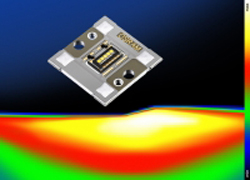
| Home | About Us | Contribute | Bookstore | Advertising | Subscribe for Free NOW! |
| News Archive | Features | Events | Recruitment | Directory |
| FREE subscription |
| Subscribe for free to receive each issue of Semiconductor Today magazine and weekly news brief. |
News
12 November 2008
Osram launches new LEDs for headlamps, camera flashes, and video displays
OSTAR Headlamp LED with new brightness data and accurate cut-off-line
Osram Opto Semiconductors GmbH of Regensburg, Germany says that, with its integrated shutter, its new OSTAR Headlamp LED simplifies optical systems by efficiently emitting clearly defined light without the need for further external shutters. The high-power LED is now equipped with one, two, three, four or five chips and can be used for any headlamp design, allowing the creation of different illumination patterns and lighting scenarios. Instead of the usual silicon encapsulation, a glass cover bonded to the frame protects the chips, as well as preventing scatter losses.
 Depending on the number of chips arranged in series, the OSTAR Headlamp LED produces between 125lm at 700mA (one chip) and 1000lm at 1A (five chips). The brightness from an unchanged power rating of 12W results from improvements in the chips, the converter and the package.
Depending on the number of chips arranged in series, the OSTAR Headlamp LED produces between 125lm at 700mA (one chip) and 1000lm at 1A (five chips). The brightness from an unchanged power rating of 12W results from improvements in the chips, the converter and the package.
Picture: New OSTAR Headlamp LED.
The thermal resistance for the five-chip version is about 3K/W. “Development work is continuing,” says Peter Knittl, head of Automotive Marketing LED. “We expect there to be a continual reduction in thermal resistance to a much lower level than at present,” he adds.
A high-precision shutter integrated into the glass provides a clearly defined beam pattern on the road without losing light, as was the case previously with mechanical shutters. Compared with conventional solutions, the mounting depth is also significantly reduced. The glass cover also makes the LED more robust.
With a color temperature of 6000K, the light color is very close to that of natural daylight, making driving safer because drivers do not get tired so quickly, says Osram Opto. Also, oncoming drivers are not dazzled because headlight manufacturers can design the bright/dark transition areas with great precision.
Different lighting scenarios can be created (e.g. high beam, low beam and cornering beam) by combining different chip configurations on which lenses can be mounted. Compared with classic HID projection systems, which emit 35-45% of the light produced, the LED solution emits 10% more, the firm reckons. With a life of 10,000-20,000 hours, LEDs also outperform conventional solutions (generally lasting longer than the vehicle).
New generation of Ceramos and Oslux LEDs for flash photography
Osram Opto Semiconductors says that its new generation of Ceramos and Oslux LED flash products are twice as bright as their predecessors, meeting the high brightness requirements imposed by the higher resolutions that can be achieved by modern digital cameras.
Ceramos is one of the brightest LED without a lens for flash photography on the market, the firm claims, producing 90lm from an operating current of 500mA. Light is produced by ThinGaN chips measuring just 1mm².
Clear encapsulation produces very bright light, but it is also available with diffused encapsulation for a neutral-white appearance. The version with diffused encapsulation appears radiant white, even when not in use, and can also be used as a design element. The LED with transparent encapsulation appears slightly yellow.
The Oslux, with its special lens, is suited to use without external optics in cell phones or digital cameras. The new LED has an optimized chip and lens design that increases brightness: 100lx from an operating current of 500mA (higher brightness can be achieved with higher operating currents).
“A sizeable proportion of modern cell phones equipped with LED flash units use our high-flux LEDs,” says Dr Volker Härle, senior director LED Marketing. He reckons that uptake of the new LED flash products will be assisted by the new brighter products having the same connections, so they can be used as direct replacements for the previous generation of LED flash units.
New MultiLED generations: black for more contrast, white for greater brightness
Osram Opto is also launching two new MultiLEDs for different LED video displays, both based on high-power chips in Osram Opto's latest Thinfilm and ThinGaN technology.
The new MultiLED in the black package has been developed for high-resolution displays, targeted at the professional entertainment industry (including theater shows and trade fairs). Typical luminance is 2000cd/m² and pixel spacing is 5-7mm. As the blackest LED currently on the market, the firm claims, it provides excellent contrast and depth of color. The color appears on the display as a deep black, giving pictures great depth and creating 3D effects. “Achieving a consistent black level has been the greatest hurdle so far in presenting the color black properly,” says Härle. “Pictures will now have much more intensive depth.”
The MultiLED in the white package offers exceptional brightness, and is suited to high-resolution perimeter advertising systems or in displays with high brightness requirements. Both versions offer color fidelity across the entire viewing angle such that there are no discernible color differences even in the horizontal direction.
The white points are at 750mcd for the black package and at 2000mcd for the white package. They are supplied in very narrow tolerances in terms of brightness and color location to ensure homogeneous display results. The display colors remain constant from all viewing angles. Also, the multichip LEDs’ 6-lead design ensures good heat removal and allows currents of 15mA per color even at an ambient temperature of 85°C.
Search: Osram LEDs GaN Automotive LEDs
Visit: www.osram-os.com